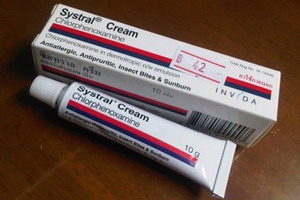 The active ingredient of Chlorphenoxamin is applied as a cream or gel to the skin to relieve sensitivity (allergic) skin reactions (allergic) such as burning, itching, redness, and swelling.
The active ingredient of Chlorphenoxamin is applied as a cream or gel to the skin to relieve sensitivity (allergic) skin reactions (allergic) such as burning, itching, redness, and swelling.
Is this ingredient for what purposes?
- Alleviate itching in allergic skin diseases
- Alleviate itching with hives, eczema, insect bites and sunburn
- Alleviate complaints to Chilblains
- Alleviate discomfort for light Burns
- Alleviate complaints to allergy of skin
- Treat skin infections.
How Chlorphenoxamin works
Learn more about the applications and the action of Chlorphenoxamin below. Read also the information about the active range of H 1 – antihistamines, to which belongs the active ingredient Chlorphenoxamin.
Fields of application of the active substance: Chlorphenoxamin
The active ingredient of Chlorphenoxamin is applied as a cream or gel to the skin to relieve sensitivity (allergic) skin reactions (allergic) such as burning, itching, redness, and swelling.
He is used for the local treatment of allergic and itchy skin diseases and skin infections such as urticaria and eczema as well as insect bites and stings, jellyfish Burns, sunburn, slight Burns and cold damage of the skin such as, for example, Chilblains.
In-depth information is available to the following application areas of Chlorphenoxamin:
- Allergy
- Skin infections
- Eczema
- Itching
- Sunburn
Mode of action of Chlorphenoxamin
The active substance Chlorphenoxamin belongs to the Group of H 1 – antihistamines and shows their mode of action. So the effect of the body’s Messenger substance is inhibited histamine 1 receptor on the H, because Chlorphenoxamin ousted the histamine from the receptor.
Histamine causes hypersensitivity reactions of the skin such as itching, swelling of the tissue and fluid discharge into the fabric. These skin reactions are suppressed by the inhibition of histamine. The itching stasis of Chlorphenoxamin is pronounced by the additional light local anaesthetic (local anaesthetic effect). The effect inserts very quickly.
As the fat-soluble active substance adheres well to the skin Chlorphenoxamin and is therefore perfectly suitable for local use.
Warnings and precautions
The active ingredient may not come with the eyes in contact. After accidental eye contact must flush thoroughly with water.
Remedy ingredients sometimes trigger allergic reactions. Should you perceive signs of an allergic reaction, so you tell your doctor or pharmacist promptly.
What interactions shows Chlorphenoxamin?
It is important to note that the interactions can be different depending on the pharmaceutical form of a drug (for example, Tablet, syringe, ointment).
The action of Central absorbing drugs such as painkillers (analgesics), sedatives (hypnotics), maprotiline (Narcotics), active substances for the treatment of psychological disorders (drugs) and alcohol can be strengthened with simultaneous use of Chlorphenoxamin.
Contra-indications
The following information about contra-indications in the application of Chlorphenoxamin in General, pregnancy & lactation, and in children. It is important to note that the contra-indications can be different depending on the pharmaceutical form of a drug (for example, Tablet, syringe, ointment).
When may Chlorphenoxamin not be used?
The active ingredient may not be applied when hypersensitivity against Chlorphenoxamin as well as nässenden, acute Juckflechten (eczema), bladder voiding disorders with residual urine formation and narrow-angle glaucoma.
Chlorphenoxamin is also not for the large-scale application (for example, when severe burns and scalds) in infants and young children. Here, immediate medical attention is necessary.
What must you consider when pregnancy and breast-feeding?
Investigations so far revealed no evidence that the active substance Chlorphenoxamin harms the unborn child. However, should the active substance are applied not extensively in the first three months of pregnancy on the skin.
To avoid direct contact of the infant with the active ingredient, Chlorphenoxamin may be applied during breastfeeding not at or close to the nipples.
What is taken into account in children?
The active ingredient may, be used sparingly, used for the skin treatment of children.
Chlorphenoxamin may be applied for infants and young children not extensively on the skin.
What side effects can Chlorphenoxamin have?
Below, you will learn the most important thing possible, well-known side effects of Chlorphenoxamin. These side effects should not occur, but can. Because everyone reacts differently to medications. Please also note that the side effects in type and frequency can vary depending on the pharmaceutical form of a drug (for example, Tablet, syringe, ointment).
Uncommon side effects: easy burning.
Rare side effects: hypersensitivity reactions of the skin such as redness and Exantheme.
Very rare side effects: changes in blood count.
Side effects without frequency: Zentralnervöse complaints; Visual disturbances; Release of glaucoma (narrow-angle glaucoma); Dry mouth; Stomach disorders; Changes and discomfort during urination (micturition disorders).
Specialties: In very rare cases side effects can occur such as agitation, confusion, and operated large-scale application in children and fatigue in large-scale application in adults.

























